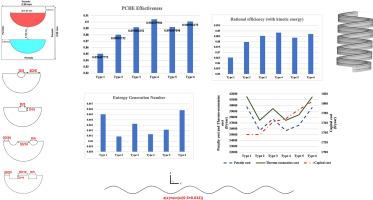A 3E (Energy, Exergy, and Economic) comparative analysis for a novel methane-nitrogen finned channel printed circuit heat exchanger at supercritical pressures in small-scale natural gas liquefaction refineries
Q1 Chemical Engineering
引用次数: 0
Abstract
Printed circuit heat exchangers (PCHEs) using nitrogen as a renewable coolant are a progressive candidate in small-scale natural gas liquefaction refineries. In response to the increasing global focus on LNG production due to the global warming challenges, this study provides a 3E analysis of the effect of longitudinal fins on the cooling process of methane at supercritical pressures. An economic evaluation based on the second law of thermodynamics applies to a counter-flow PCHE. Parameters such as Nusselt number, Richardson number, PCHE effectiveness, performance evaluation criterion, rational efficiency, and thermodynamic-economic cost are analyzed. The capital cost and the irreversibility penalty cost make the total cost of the PCHE. The results predict that the irreversibility cost can be 20 times the capital cost. The comparative results reveal that by sinusoidalizing and applying one longitudinal rectangular fin, the PCHE effectiveness increases by 6.34 %, the total entropy generation decreases by 9.1 %, the methane outlet temperature decreases by 7.57 %, the rational efficiency rises by 2.68 %, and 9.77 % reduction in thermodynamic-economic cost are obtained compared to the fin-less straight channel. This study proposes new Nusselt number correlations for methane at supercritical pressures. This study can expand the feasibility of small-scale natural gas liquefaction units to use this clean fossil fuel.

小型天然气液化炼油厂超临界压力下新型甲烷-氮翅片通道印刷电路热交换器的能源、能源和经济对比分析
使用氮气作为可再生冷却剂的印刷电路热交换器(PCHEs)在小型天然气液化炼油厂中逐渐成为候选。由于全球变暖的挑战,全球越来越关注液化天然气的生产,本研究提供了纵向翅片对超临界压力下甲烷冷却过程影响的3E分析。基于热力学第二定律的经济评价适用于逆流PCHE。分析了Nusselt数、Richardson数、PCHE有效性、性能评价标准、合理效率、热力学经济成本等参数。资金成本和不可逆性处罚成本构成了PCHE的总成本。结果预测,不可逆性成本可能是资本成本的20倍。结果表明:与无翅片的直通道相比,采用单纵矩形翅片正弦化后,PCHE效率提高了6.34%,总熵产降低了9.1%,甲烷出口温度降低了7.57%,合理效率提高了2.68%,热力学经济成本降低了9.77%。本研究提出了超临界压力下甲烷的新努塞尔数相关关系。本研究可以扩大小型天然气液化装置使用这种清洁化石燃料的可行性。
本文章由计算机程序翻译,如有差异,请以英文原文为准。
求助全文
约1分钟内获得全文
求助全文
来源期刊

International Journal of Thermofluids
Engineering-Mechanical Engineering
CiteScore
10.10
自引率
0.00%
发文量
111
审稿时长
66 days
 求助内容:
求助内容: 应助结果提醒方式:
应助结果提醒方式:


